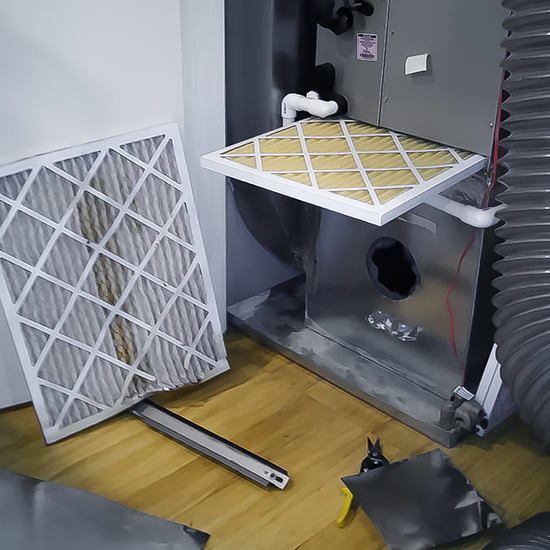Since climate change is ongoing to transform our environment, its effects is being experienced across various industries, such as heating, ventilation, and cooling, often known as HVAC. Rising heat and changing climate patterns are prompting homeowners and businesses to reassess their HVAC units. have a peek here , it's more crucial than before to understand how these systems function and the ways they can be optimized for greater efficiency and comfort in an adapting climate.
This article we will explore the intricate relationship between global warming and HVAC technology. From the newest innovations in energy-efficient systems to the necessity of maintaining indoor air quality, we will cover essential information that anyone can use to enhance their heating and cooling system. Whether you are looking to lower your utility costs, improve your home’s comfort, or respond to the challenges posed by changing weather patterns, this guide will provide valuable information into making informed decisions about your HVAC setup.
Grasping HVAC Technologies
HVAC is an acronym for heating, ventilation, & air conditioning, which collectively form the technology utilized to ensure indoor climate control. An HVAC setup is essential in maintaining the desired temperature and air quality for residential and commercial buildings. It functions by employing various elements such as furnaces, cooling systems, heat pumps, and ventilation fans to control the environment. By grasping the fundamental functions of each component, residents can better recognize how these systems work together to create a comfortable living or working space.
The warmth aspect of HVAC systems typically depends on heaters or heat exchangers to provide warmth during colder months. Heating units combust fuel or require electricity to produce heat, whereas heat exchangers relocate heat from the ambient air or the ground into the structure. On the flip side, air conditioning units function to cool indoor areas during warmer seasons. These units work by removing heat from the indoor air and releasing it to the exterior, often using a refrigerant to assist the heat exchange procedure. A efficient HVAC system ensures that the home continues comfortable throughout the year.
Ventilation is an additional essential component of HVAC systems. It fulfills a significant role in maintaining indoor air quality by bringing in fresh outdoor air and removing stale indoor air. Proper ventilation can assist reduce indoor pollutants, allergens, and humidity levels, contributing to a healthier environment for people. Many contemporary HVAC systems include sophisticated filtration and humidity control features, further enhancing overall air quality and comfort. By comprehending these mechanisms, users can make knowledgeable decisions about their maintenance and upgrades, particularly in the context of shifting climate conditions.
HVAC Maintenance and Effectiveness

Routine maintenance is crucial for guaranteeing the effectiveness and durability of your HVAC system. Easy tasks such as changing vent filters, cleaning ducts, and checking components can prevent minor issues from growing into costly repairs. A thoroughly cared for system not only operates more effectively but also uses less energy, which translates to lower utility bills. Planning seasonal tune-ups can help identify potential issues early and keep your system operating at peak performance.
Additionally, comprehending the specific needs of your heating and cooling system can increase its effectiveness. Diverse units may require distinct maintenance routines based on their kind, vintage, and application. Monitoring an eye on the thermostat settings is also important; setting it wisely can minimize strain on your system. By being proactive and conscientious of these factors, homeowners can noticeably prolong the life of their HVAC systems while enjoying a cozy indoor environment.
Incorporating intelligent technologies for monitoring and controlling your HVAC can lead to improved effectiveness. Contemporary HVAC systems equipped with smart thermostats allow users to observe energy usage patterns, change temperatures remotely, and receive messages on maintenance needs. By adopting cutting-edge solutions, homeowners can optimize their systems, ensuring that they not only meet their heating and cooling requirements but also aid to overall energy efficiency and financial savings.
Advancements in HVAC Technology
The HVAC sector is experiencing significant advancements driven by the need for energy efficiency and eco-friendliness. One of the most revolutionary developments is the integration of smart technology into HVAC units. Smart controls and sensors allow homeowners to monitor and control their heating and air conditioning systems from a distance, optimizing energy use and reducing expenses. These gadgets learn user preferences and can adjust settings automatically based on environmental factors, enhancing comfort while minimizing energy consumption.
Another major innovation is the introduction of variable refrigerant flow systems. These systems are designed to provide precise temperature control and are more efficient than traditional HVAC units. By using cutting-edge technology to adapt the refrigerant flow based on the heating and cooling demands of different areas, these units enhance energy savings and improve indoor comfort. They are particularly beneficial in commercial settings where diverse temperature zones are often present.
Additionally, the emergence of eco-friendly HVAC solutions, such as geothermal systems and solar-powered systems, marks a significant trend in the industry. Geothermal technologies harness the stable temperature of the earth to provide heating and cooling, significantly reducing utility expenses and environmental impact. Solar-powered HVAC systems utilize renewable energy to operate, making them an appealing option for environmentally aware consumers. These developments not only support energy efficiency but also help mitigate the adverse effects of climate change, paving the way for a sustainable future in HVAC solutions.
